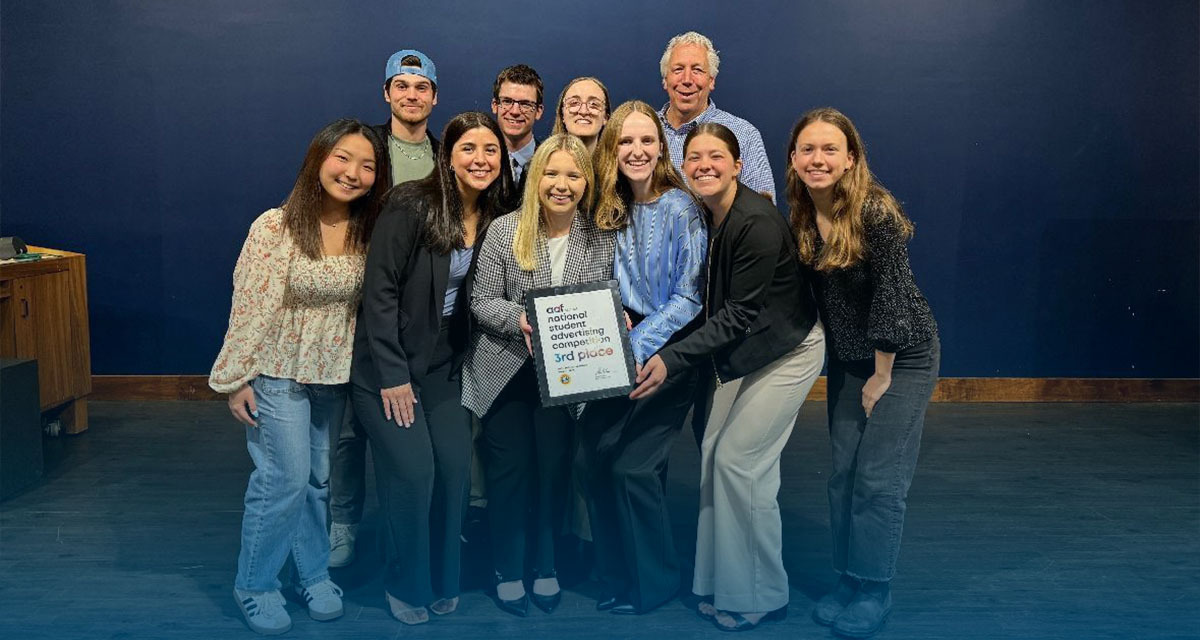Gordon College Students Secure Third Place in NSAC with Tide Campaign
On April 27 a team of Gordon students hosted and competed in the National Student Advertising Competition (NSAC) for the New England district, placing third for a second year in a row. Led by Professor Greg Smith (business and marketing) and project manager Gabby Bergstrom ’24, the team created a comprehensive marketing campaign and case study for Tide, the highest-selling detergent brand in the world.
“They were definitely the best presenters from the teams,” Smith said. “Everyone on the team did a fantastic job. The level of professionalism was just incredible; they grew so much, and their content was well done. It was one of those things where the judges had a hard time deciding.”
What is NSAC?
The NSAC is the premier college advertising competition, organized through the American Advertising Federation— one of the nation’s oldest and most reputable advertising industry trade associations. This national competition provides more than 2,000 college students with the real-world experience of creating a strategic marketing campaign for a corporate client.
This year the prompt came from Tide, asking students to convince 18- to 35-year-olds to wash their laundry with cold water to help the environment. The student teams had complete creative control over the assets they created for the multi-touch campaign: social media strategy, partnerships, commercials, event ideas, influencer marketing campaigns and even rebranding, if desired.
Last year’s team competed on their own time, but given the time investment required for the competition, this year Smith turned it into a class. This way students could get credit for their work and also have dedicated time to work together. Even if students had never created a marketing pitch before, “a big part of this competition is helping [them] learn the necessary skills and aspects of strategizing a marketing campaign and watching them grow,” Smith said.
Preparing for the Marketing Competition
The students promptly created teams to tackle the work based on their strengths and passions. Their groupings naturally reflected the organizational structure they might encounter in the workplace: social media, graphics, data research, partnerships and events.
Brenndan Teeter ’26, a business management and marketing double major with a minor in data science, was on the data research team. He used MRI Simmons, a platform for secondary research, to conduct surveys and SurveyMonkey and social media polls to assess how the targeted demographic felt about laundry and the environment. His team even went out to some local stores and interviewed people in real-time to collect data. This was the foundation for the group’s strategy, as well as the campaign’s budget.
Teeter, who also competed in last year’s ad competition, says that through this work, “I realized marketing isn’t just a creative element. There is data analysis in here, and that’s what I ultimately want to do [as a career]. It’s looking at data and figuring out how can we use it to ultimately bring about our end goal.”
The Final Face-Off
For the final competition a select group of the 15 participating Gordon students gave the presentation, including Madison Vavala ’24, a marketing, economics and business management triple major. In addition to a 13-page case study, the group gave a 20-minute marketing pitch complete with slides showing their data impressions, suggested partnerships, social media ads and new tagline: “Turn Down the Heat.”
“In the week and a half to two weeks leading up to it, we probably spent anywhere between an hour and a half to three hours, five days a week, practicing and getting reps on our presentation,” Vavala said. “Every word we say must have meaning behind it because it’s going to be picked apart by the judges. We wrote a whole script so that we were saying exactly what we wanted. I felt like I was a theater major!”
Key Takeaways
All students who participated in the competition valued the hands-on marketing skills and knowledge it provided them. “Before this I really haven’t had a lot of experience with this kind of hands-on data,” Teeter said. “I think being able to learn that gave me more insight into what I want to do in the future.”
“Something that I love about this competition is that I have a lot of friends at bigger schools who are doing things like this in their classes,” Vavala added. “When Gordon does things like this, it’s giving me the real-life experiences my peers have. The competition in general helped us see the way that everything works together. I think it’s fascinating to see how many different parts we put into this. Now we know a little bit of how corporate companies do it too.”
 The Bell
The Bell